Visit the Tojiro factory with us
Traveling in Japan is comfortable and exciting, but not cheap at all. Finally, just like everything else. After all, what can be expected from a country where the average monthly income significantly exceeds the limit of 3000 EUR. For this reason, it is definitely worth planning your trip carefully. The preparation of the trip begins several months before its implementation. In addition to routine matters such as airline tickets and hotels, it is extremely important to arrange a meeting with key people. Otherwise, you will become tourists, which in our case is unthinkable.
We chose Niigata Prefecture for purely pragmatic reasons. It is located in the suburb of Tsubame - Sanjo, which is one of the main Japanese cutlery centers. The concept of a suburban came to mind when we found out that these cities are separated by a common modern railway station. It's like putting a ruler on a city map and making a line. You will call one half of the city Tsubame and the other Sanjo. We know nothing about the competitive relations of these cities, because the Japanese will not reveal anything to you out of decency.
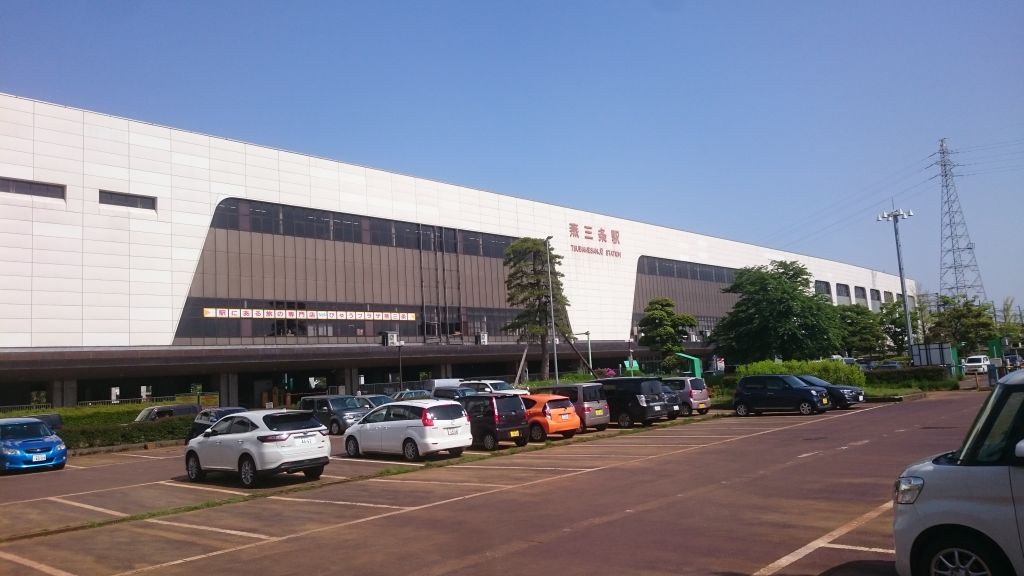
Railway station Tsubame Sanjo
The goal of our trip was clear. After all, in Tsubame they have their factories of the brand Tamahagane , Tojiro and Global . The best way to get to Tsubame is by train from Tokyo. A comfortable shinkansen will take you there in less than two hours. I have been there for two days already and I have had a very exciting visit to the Kataoka factory, which produces the Tamahagane brand. Her owner, Kataoka-san, was preparing me to see something completely different in the case of Tojiro. "Tojiro now has two factories, one real and one for visitors. "Only the other one will show you tomorrow," Kataoka-san laughed. I confess, I'm lying in bed with some disappointment.
In the morning, well in advance, as is customary in Japan, I go out in front of the hotel. Shinjiro is getting out of his car. Oh, you probably don't know Shinjiro. He is a great friend and I am always looking forward to meeting him. Interestingly, visually, and I emphasize this, really only visually, he does not resemble the Japanese at all. That is, looking away from the shape of his eyes. He is almost 190 cm tall, has relatively little hair and speaks beautiful English. But taking into consider his behaviours, he is, in a good way, a real Japanese. Shinjiro is in charge of exporting the Tojiro brand and spends much of the year at exhibitions and fairs. He studied in the USA, worked in Germany and after returning to Japan he chose a job according to the location. From Tokyo, where he was born, he tried to escape as much as possible. He was attracted by the beautiful nature of Tsubame, so he did not hesitate.
"We'll spend two days together, so I planned it all," he told me as we got in the car. "I'll show you our headquarters and the showroom , then the factories and, after lunch, the dispatch center. We will take over your new orders tomorrow and you will see our entire range in the next showroom. If we have some time left, I'll show you a Shinto shrine a short distance from my house. And on the third morning I throw you at the airport in Niigata.“
The complexity of his plan did not surprise me, I am already used to it in Japan. I thought about the plural of the word factory. Would it? We have already entered the industrial part of the city. We stopped in front of a tastefully designed office building. I knew her from the catalogs. An example of pure Japanese functionalism. The first steps led to the business owner. Susumu Fujita greeted me politely. I noticed that Shinjiro's desk was right next to the owner. It is a clear proof of his position in the company. Shinjiro initiated the boss into our plan, and he congratulated him. We exchanged a few courtesy phrases and went to work.
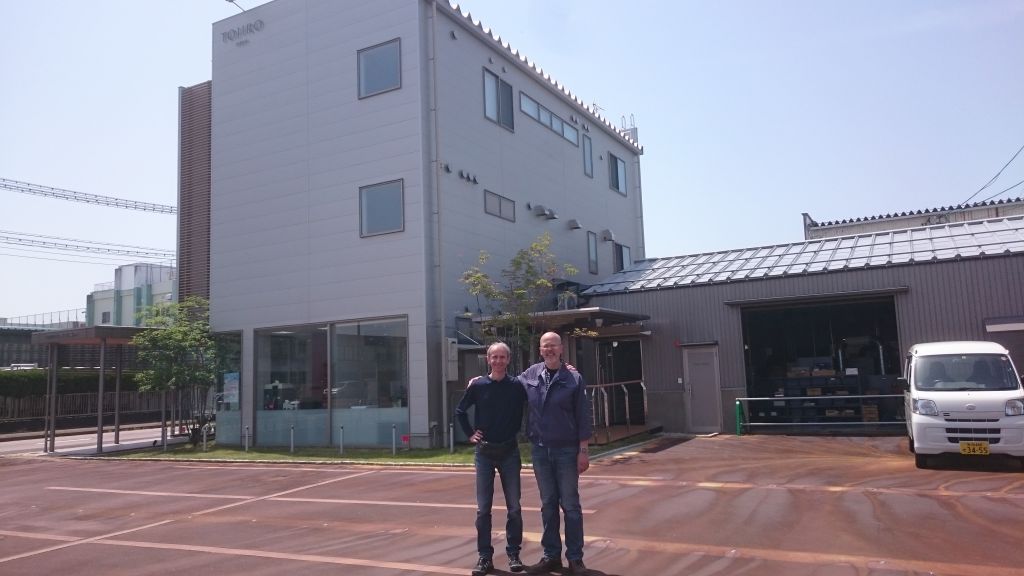
Witho Shinjirom in front of Tojiro company
"We have two factories here," my guide began. "One is used for the production of our products and the other was set up to explain the individual production procedures to the visitors. Which one do you want to see first? ” I don't have to explain to you how I felt. I was ranked among the trustworthy, among those who are allowed to look into the cuisine of a Japanese company. I didn't hesitate for a moment. "Let's start with the real one,"I answered.
About 100 meters behind the office building is the main factory of Tojiro. It's much better than the ones I've visited so far. It excels in organization and cleanliness. My host nevertheless apologized for the dirt caused by the production. What a Japanese. As it is understandable that it is not possible to share technological practices with you on this platform, I will continue to adhere to the popular nature of the article. It is interesting for our people, for example, that when moving between individual workplaces, the workers turned for a moment, smiled and bowed. At least one felt that it did not disturb them, but paid tribute to their craft. I was surprised that in addition to experienced craftsmen, many young people work in the factory. Tojiro is gradually learning to face the widespread problem of Japanese knives today - the shortage of workers. The work is demanding. You have to accept noise, heat, cold and stress. No armchairs, air conditioners, tablets and mobile phones. No wonder young people are not very attracted to this craft. All this results in a shortage of goods and an extension of delivery times. Today it is more difficult to get a knife than to sell it, we are experiencing a seller's market. We gradually went through all the workplaces. At the end of production is a large blue cabin. Shinjiro jokingly commented, "This is the only dishwasher our knives will visit. The first and the last ". From there, the knives travel to the QC department, ie quality control. In a large, perfectly lit room, 14 inspectors work at large tables. They are mostly women who carefully turn over the knife in white gloves and look for even the smallest defect. Packing and shipping follows.
The Tojiro premises are very nice. Everything is logically connected and looks compact. No objects are seemingly "scattered" around the land. The entrance to the complex is dominated by an administrative building, which is a kind of company coat of arms. The end of the area is occupied by a "real" factory. These two main buildings are connected by lower buildings that hide the "displey factory". Factory for visitors. On the way to it, we go through the section that really surprised me. Tojiro's production program is extensive. The vast majority are embossed kitchen knives of various materials. In addition, the company has a slim, two-page catalog of hand-forged kitchen and hunting knives . Many times we were determined to include them in our offer, but looking at the final price, the gourmet left us. I assumed that Tojiro kept these knives from external blacksmiths, as did many other companies. I was wrong. Between the real factory and the showroom there is a department aptly named Tojiro Knife Atelier. We usually call the studio bright and quiet spaces, where the creators are waiting for their muses. This is not the case. It's a real, genuine blacksmith shop. I see everything I see in the Tosa area. Forge, mechanical hammer, anvils and a lot of different steel. Of course, everything in the style of Tojiro - cleanliness and order. This is where real gems are born. 21, 37 and 63 layer blades for kitchen and hunting knives. Materials of the most luxurious: Aogami II and VG-10 for blades, buffalo and deer horns for rings and ebony, rosewood,cherry and magnolia for handles. Watching the blacksmith at work, I set a goal. These knives will one day be offered by Nippon Knives.
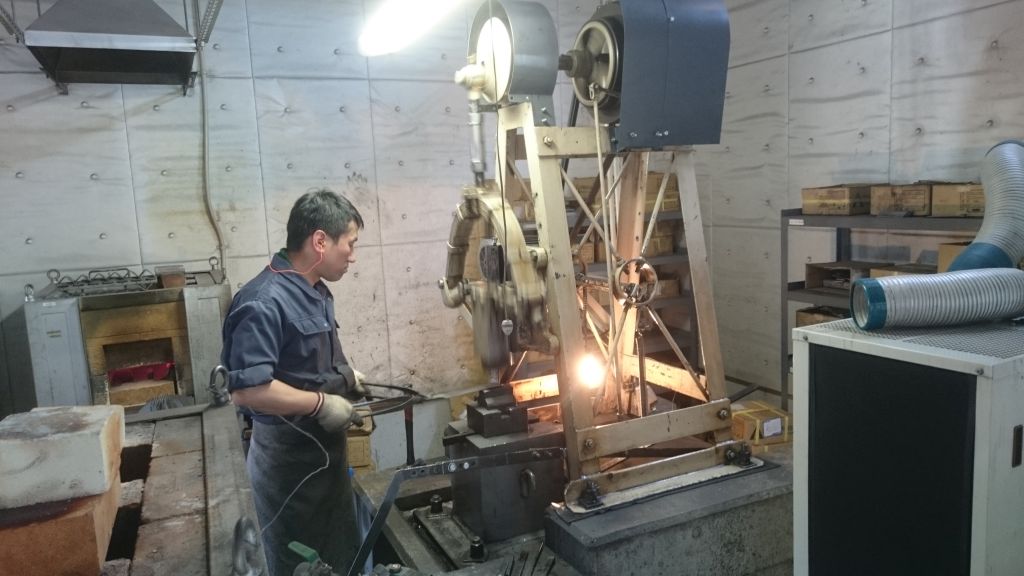
Master from Tojiro Knife Atelier
From Tojiro Knife Atelier we move smoothly into the pride of the whole area. It is a modern hall in which the individual workplaces are located in a logical sequence. From the press, through the cutter, vertical grinders, polishers, horizontal grinding stones to the laser cutter. There is a wood-paneled sidewalk around the perimeter, from where the visitor can observe the individual actions. A panel is installed at each stand to properly understand the operation. Two products are mounted on it, one before the operation and the other the resulting one. The only flaw of this perfectionism is the absence of English texts. When we get to the heart, we go up the stairs to the gallery, where the semi-finished products from the individual stages of production are arranged chronologically. Even a person who has no idea how a knife is made, will understand many things after visiting the Tojiro Display Factory..
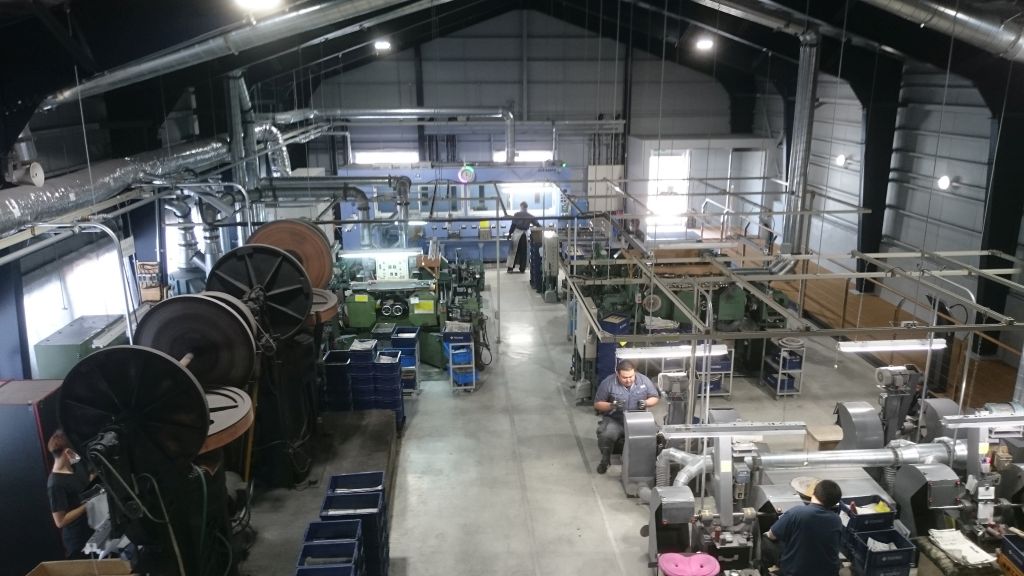
Tojiro Display Factory
After a late lunch at a nearby buffet, which reminded us of our fancy Asian restaurants, we return to the administration building. The showroom is located on the ground floor. Here you will find the current Tojiro offer. With sips of quality matcha tea, I think about what else to bring to our customers. I admit, I've found a few tips, but I won't reveal them yet. Cooking classes are also held in the building and the premises are also provided to local associations.
On leaving to the hotel, I noticed the reddish color of the local roads. Shinjiro explained to me that even though the winters here are not too harsh, the snow used to fall. Then they let groundwater through the steel-lined holes in the middle of the road, which will melt the snow. As the water contains many minerals, it is colored red.
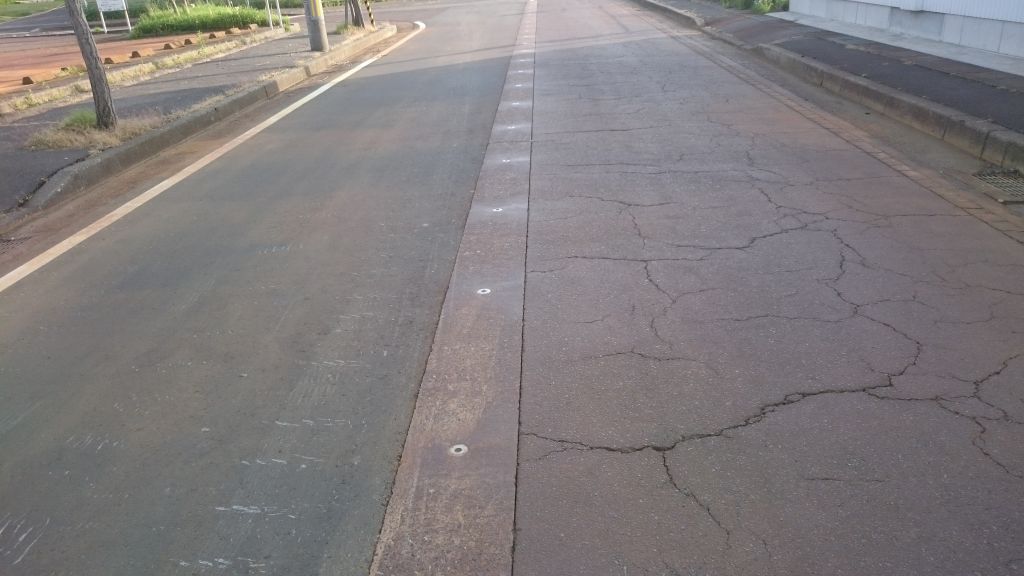
Sophisticated snow melting system
We spend the next day visiting the company's dispatch center. It is a 20-minute drive from the factory. It is located in a multi-storey building, where, in addition to warehouses, the administration and a huge showroom have also found a place. The transport of goods from the factory creates certain costs, but the building of the dispatch center is owned by Mr. Fujita, so it makes logical sense. In addition, it is located on the premises of wholesale companies, from where production from Tsubame and Sanjo is shipped throughout Japan. I'm going through the warehouse and I'm missing cartons marked France, UK, Italy, Sweden, USA, Spain, UAE ... but I still can't find the right one. "Look, your shipment left yesterday," Shinjiro smiled. Too bad, I thought, I'd write a joke for colleagues on cartons. We took a freight elevator to the highest floor, where the main showroom is located. You will find everything that has ever been produced in this company. From small herbal scissors through a soba cutter to a huge yanagi, resembling a samurai sword. Here, traders choose the assortment and contract deliveries. A convenient place to fine-tune our new orders.
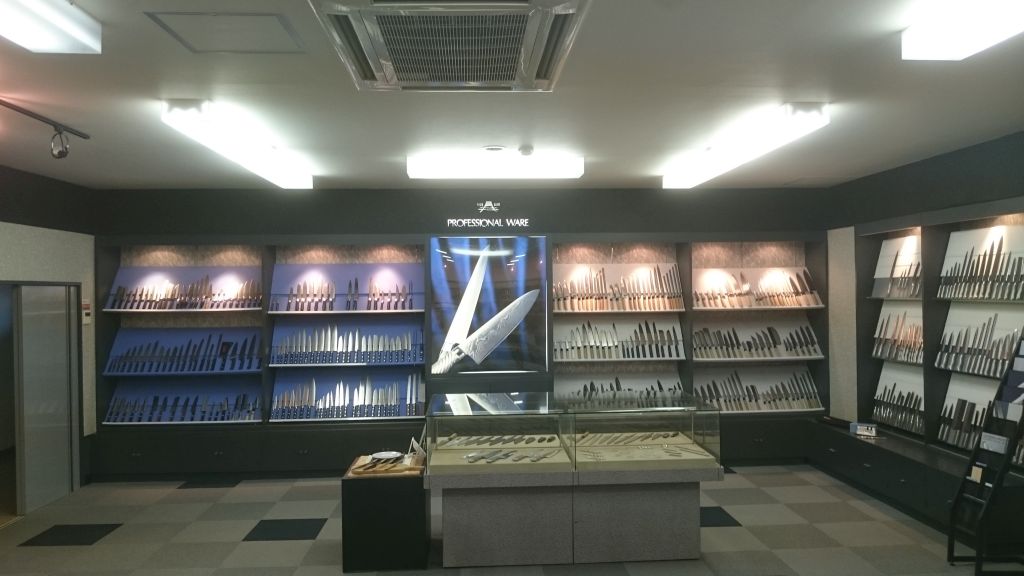
One of Tojiro showrooms
Late in the afternoon we alocated some time for the culture. Shinjiro took me to Yahiko shrine. It is an important Shinto shrine hidden in the nearby mountains. It was founded in the 8th century, but today is a replica, as the original was subject to fire. This quiet and spiritually overflowing environment is the right place to say goodbye to Niigata Prefecture.
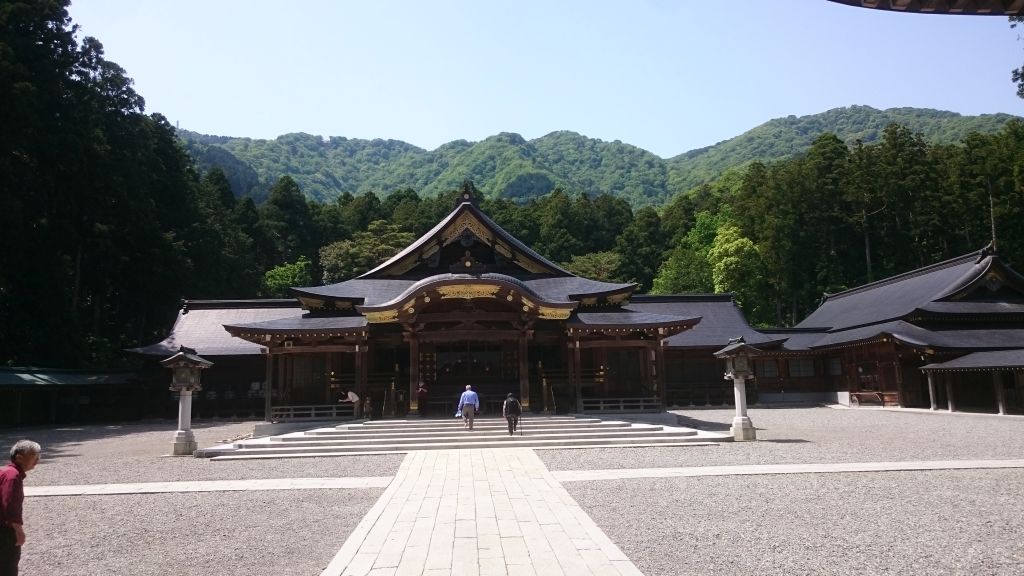
Yahiko shrine


 Sign in
Sign in Registration
Registration



























